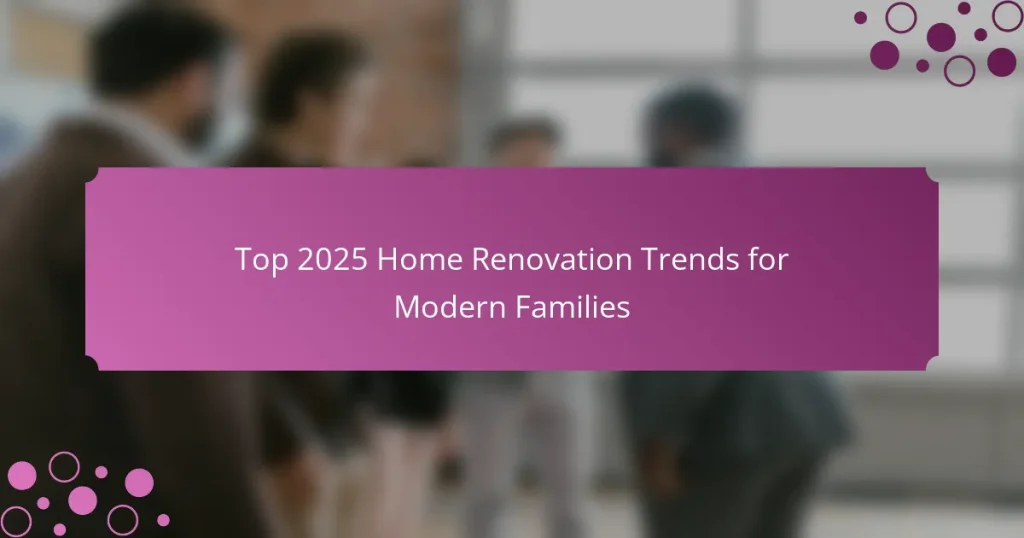As we look ahead to 2025, home renovation trends for modern families are increasingly centered around functionality, sustainability, and advanced technology. These trends not only cater to the evolving needs of families but also emphasize comfort and a harmonious connection with nature. By understanding and embracing these innovations, families can create living spaces that reflect their unique lifestyles while promoting efficiency and environmental responsibility.
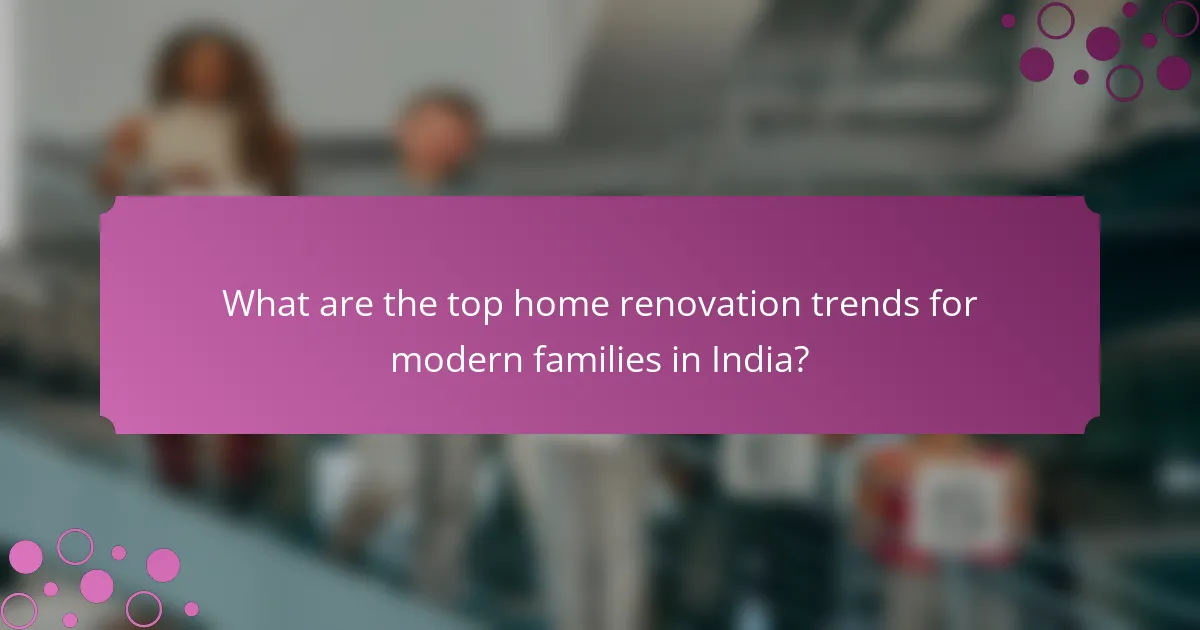
What are the top home renovation trends for modern families in India?
The top home renovation trends for modern families in India focus on creating functional, sustainable, and technologically advanced living spaces. These trends reflect the evolving needs of families seeking comfort, efficiency, and a connection with nature.
Open-concept living spaces
Open-concept living spaces are increasingly popular among modern families in India, promoting a sense of togetherness and fluidity. By removing walls between the kitchen, dining, and living areas, families can enjoy more interaction and a brighter environment.
When considering an open layout, think about how to maintain privacy and noise control. Use furniture arrangements or decorative screens to define spaces without sacrificing openness. This design often requires careful planning of lighting and airflow to ensure comfort throughout the area.
Smart home technology integration
Integrating smart home technology is a key trend for modern families, enhancing convenience and security. Features like smart lighting, thermostats, and security systems can be controlled remotely, making daily life more manageable.
When implementing smart technology, prioritize compatibility and ease of use. Look for systems that can be integrated with existing devices and offer user-friendly interfaces. Consider investing in energy-efficient appliances that can help reduce utility costs while providing modern conveniences.
Sustainable materials and practices
Using sustainable materials and practices is essential for modern families looking to minimize their environmental impact. This trend includes sourcing eco-friendly materials like bamboo, recycled metals, and low-VOC paints.
To adopt sustainable practices, consider energy-efficient installations such as solar panels or rainwater harvesting systems. Research local suppliers who offer sustainable options and be mindful of waste reduction during renovations by recycling materials whenever possible.
Multi-functional furniture solutions
Multi-functional furniture solutions are ideal for maximizing space in modern homes, especially in urban areas where square footage is limited. Pieces that serve multiple purposes, like sofa beds or extendable dining tables, can adapt to various needs.
When selecting multi-functional furniture, prioritize quality and durability to ensure longevity. Measure your space accurately to choose items that fit well and enhance the overall design without overcrowding the area.
Outdoor living enhancements
Enhancing outdoor living spaces is a growing trend, allowing families to enjoy nature and entertain guests. Features like patios, gardens, and outdoor kitchens extend the usable area of the home and promote a healthy lifestyle.
To create an inviting outdoor space, consider incorporating comfortable seating, shade structures, and landscaping that complements your home. Invest in weather-resistant materials to ensure durability and plan for seasonal changes to maintain the space throughout the year.
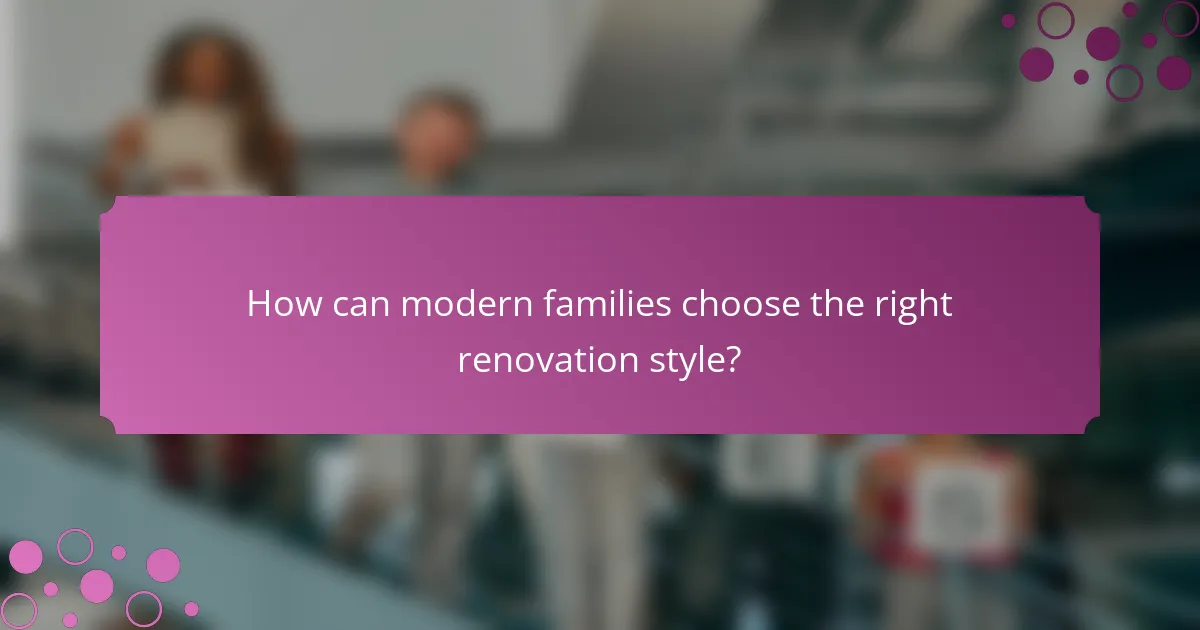
How can modern families choose the right renovation style?
Modern families can choose the right renovation style by assessing their specific needs and preferences while considering current design trends. Understanding how each style aligns with family dynamics and lifestyle will help in making informed decisions.
Assessing family needs and lifestyle
Begin by evaluating your family’s daily routines and activities. Consider factors such as the number of family members, their ages, and any special requirements like accessibility features for elderly or disabled individuals. This assessment will guide the functional aspects of your renovation.
Next, think about how your family interacts within the home. Open floor plans may suit active families who enjoy communal spaces, while more segmented layouts might benefit those who value privacy. Prioritize spaces that enhance your family’s lifestyle, such as play areas for children or home offices for remote work.
Exploring popular design aesthetics
Familiarize yourself with trending design aesthetics that resonate with modern families. Styles like minimalism focus on simplicity and functionality, while Scandinavian design emphasizes warmth and comfort through natural materials. Each aesthetic can influence the overall feel of your home.
Consider blending elements from different styles to create a unique look that reflects your family’s personality. For instance, combining industrial features with cozy accents can yield a welcoming yet contemporary environment. Researching local design trends can also provide inspiration tailored to your region’s culture and climate.

What are the benefits of eco-friendly renovations?
Eco-friendly renovations offer numerous advantages, including reduced energy consumption, healthier living environments, and increased property values. By incorporating sustainable materials and energy-efficient systems, families can enjoy long-term savings and a positive environmental impact.
Lower energy costs
One of the primary benefits of eco-friendly renovations is the potential for lower energy costs. By upgrading insulation, installing energy-efficient windows, and utilizing renewable energy sources like solar panels, homeowners can significantly reduce their monthly utility bills. Many families report savings of 20-50% on energy expenses after making these improvements.
To maximize savings, consider energy-efficient appliances that meet ENERGY STAR standards. These appliances use less electricity and water, contributing to lower overall costs while providing the same level of performance.
Improved indoor air quality
Eco-friendly renovations can lead to improved indoor air quality, which is essential for the health and well-being of families. Using low-VOC (volatile organic compounds) paints, natural materials, and proper ventilation systems helps minimize harmful pollutants in the home. This is particularly important for families with children or individuals with respiratory issues.
Incorporating plants into your renovation can also enhance air quality. Certain plants, such as spider plants and peace lilies, naturally filter toxins and increase oxygen levels, creating a healthier living space.
Increased property value
Investing in eco-friendly renovations can increase your property’s value, making it more attractive to potential buyers. Homes with energy-efficient features often command higher prices in the market, as buyers are increasingly looking for sustainable options. Renovations that focus on energy efficiency, such as solar panel installations or high-efficiency heating systems, can yield a return on investment of 70-90% or more.
When considering renovations, prioritize upgrades that appeal to eco-conscious buyers. Features like rainwater harvesting systems, energy-efficient landscaping, and sustainable flooring can set your home apart in a competitive market.

What are the costs associated with home renovations in India?
The costs associated with home renovations in India can vary widely based on the scope of work, materials used, and location. On average, homeowners should expect to spend anywhere from a few hundred to several thousand Indian Rupees per square foot, depending on the complexity of the project.
Average renovation costs per square foot
In India, the average renovation costs per square foot typically range from INR 1,500 to INR 3,500. Basic renovations like painting or flooring may fall on the lower end, while more extensive updates, such as kitchen or bathroom remodels, can push costs higher. Factors like urban versus rural location and the choice of materials significantly influence these prices.
For example, a simple kitchen update might cost around INR 1,800 to INR 2,500 per square foot, while a luxury bathroom renovation could exceed INR 3,500. It’s essential to obtain multiple quotes from contractors to get a clearer picture of expected costs.
Budgeting for unexpected expenses
When budgeting for home renovations, it’s crucial to account for unexpected expenses, which can add 10% to 20% to your total budget. These surprises often arise from hidden issues like plumbing or electrical problems that become apparent only during the renovation process.
To prepare for these contingencies, set aside a separate fund specifically for unforeseen costs. This approach helps ensure that you can complete your project without financial strain. Additionally, communicate openly with your contractor about potential risks and how they can be mitigated.
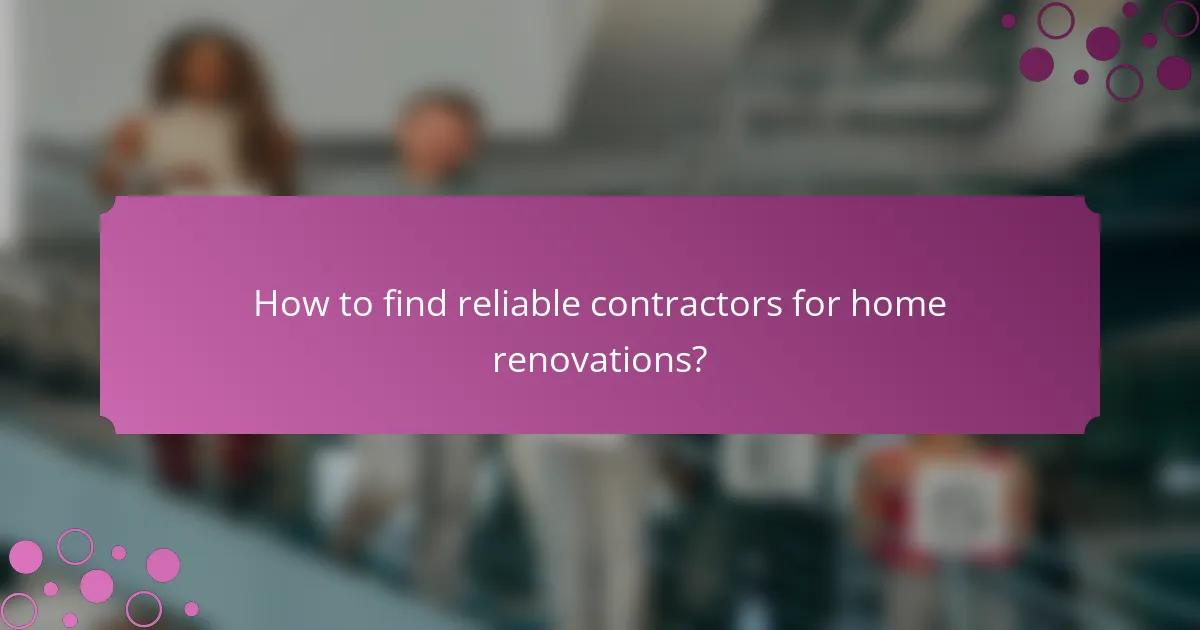
How to find reliable contractors for home renovations?
Finding reliable contractors for home renovations involves thorough research and careful evaluation. Start by seeking recommendations from friends or family and then verify their credentials and past work.
Checking credentials and reviews
Begin by confirming that contractors hold the necessary licenses and insurance required in your area. In the United States, for example, many states mandate specific licenses for general contractors, electricians, and plumbers.
Next, read online reviews on platforms like Google, Yelp, or Angie’s List. Look for contractors with consistently high ratings and detailed feedback about their work quality and professionalism.
Requesting detailed quotes
When you find potential contractors, request detailed quotes that outline the scope of work, materials, and labor costs. This transparency helps you compare offers and understand what each contractor includes in their pricing.
Be cautious of significantly low bids, as they may indicate hidden costs or subpar materials. Aim for quotes that fall within a reasonable range based on your project’s complexity and local market rates.
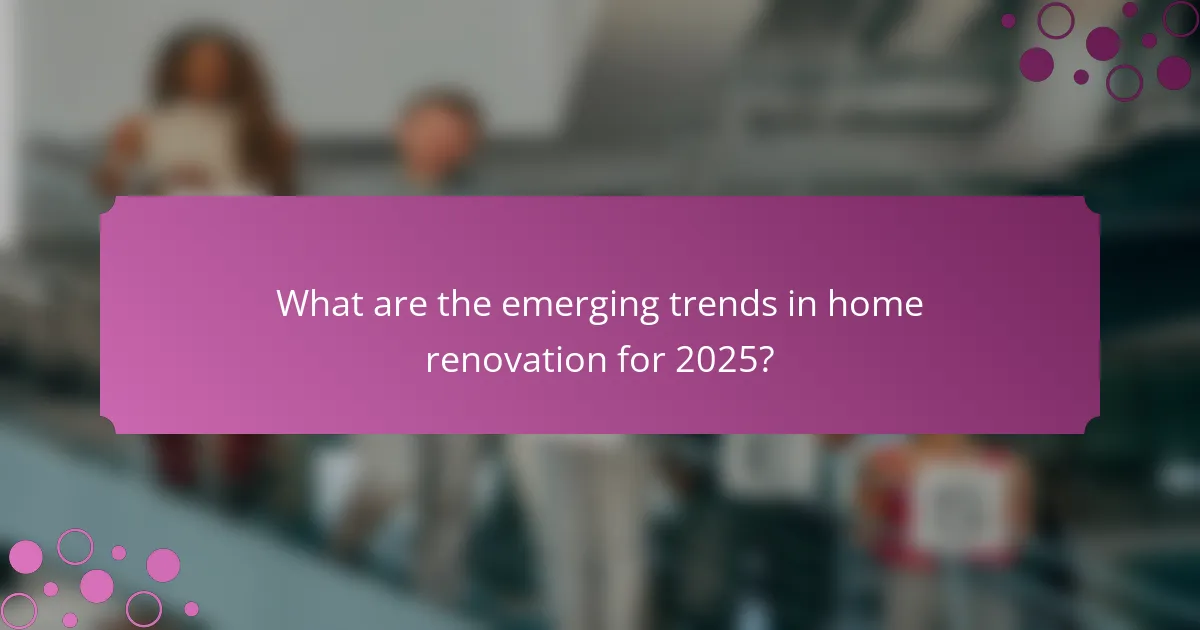
What are the emerging trends in home renovation for 2025?
In 2025, home renovation trends are increasingly focused on sustainability, technology integration, and wellness. Modern families are prioritizing designs that enhance their living spaces while being environmentally friendly and promoting a healthy lifestyle.
Biophilic design elements
Biophilic design elements incorporate natural materials, light, and greenery into home renovations to create a connection with nature. This approach enhances well-being and can improve air quality, making homes more inviting and healthier for families.
To implement biophilic design, consider adding features like large windows for natural light, indoor plants, and natural wood finishes. These elements not only beautify spaces but also foster a calming atmosphere, which is essential for family life.
When planning renovations, aim for a balance between indoor and outdoor spaces. For instance, creating seamless transitions with sliding glass doors or incorporating green walls can significantly enhance the home’s aesthetic and functional appeal.
